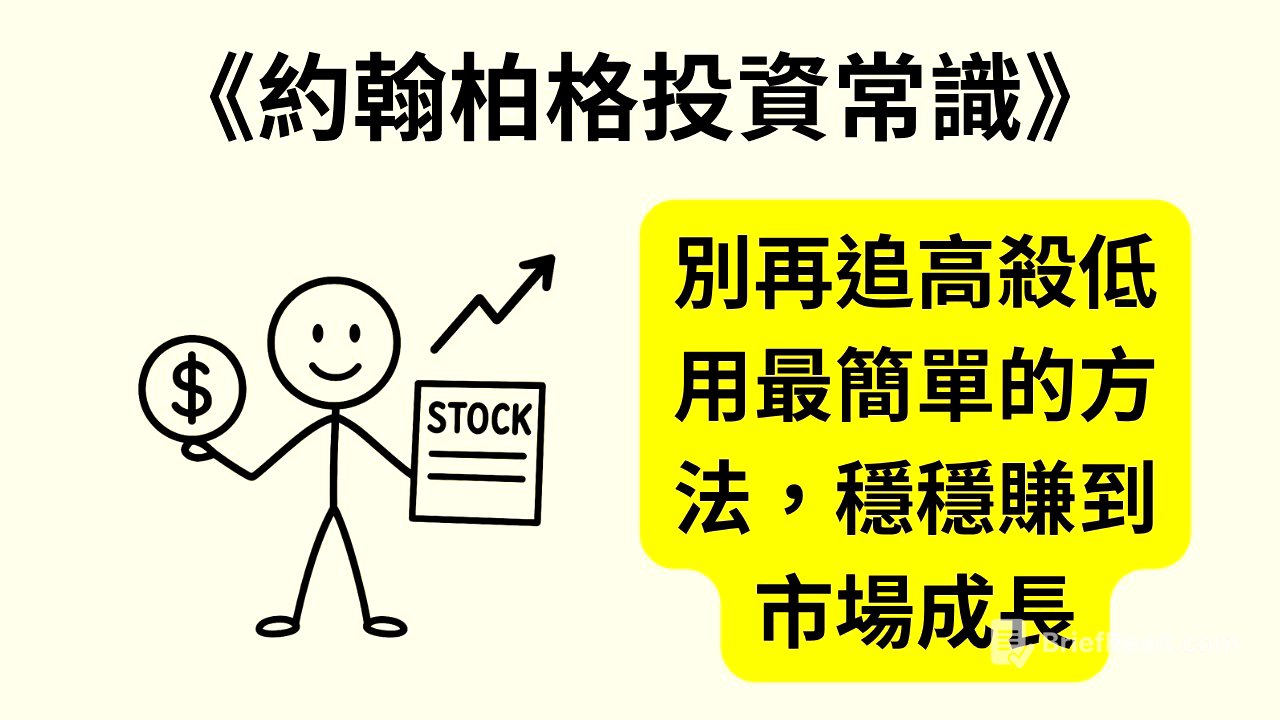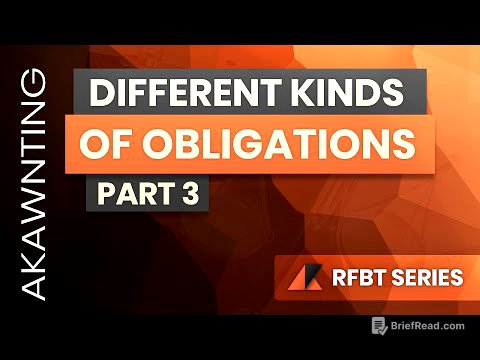TLDR;
This video summarizes John Bogle's "Common Sense in Investing," advocating for a simple, low-cost, and long-term approach to investing. It emphasizes the importance of index funds, diversification, and minimizing fees to achieve market returns. The video also warns against common pitfalls like chasing hot stocks, market timing, and emotional decision-making.
- Invest in index funds to "own the entire market" rather than trying to pick winners.
- Minimize costs (fees and taxes) to maximize long-term returns.
- Diversify investments to reduce risk and ensure stability.
- Adopt a long-term perspective and avoid emotional reactions to market fluctuations.
常識的力量:真正的投資智慧 [0:00]
The video introduces John Bogle's "Common Sense in Investing," which challenges the conventional wisdom of chasing high-return stocks and funds. Bogle advocates for "owning the entire market" through index funds, emphasizing long-term holding and cost reduction. This approach allows investors to share in the market's rewards fairly. Even Warren Buffett recommends Bogle's book for ordinary investors seeking stock market success. Bogle, the founder of Vanguard, pioneered index funds in the 1970s, promoting low-cost, market-wide investing for everyone. His company structure ensures profits return to investors, embodying his "born for investors" philosophy.
輸家的遊戲:為什麼被動投資會贏 [2:15]
The video explains that the stock market is a "zero-sum game" where transaction costs mean most participants lose to the market itself. Trying to "beat the market" often leads to losses due to overactivity. The real "winner game" is long-term holding of the entire market via index funds. Active fund managers, despite their efforts, often underperform compared to the index after fees. Embracing the market through index funds is a smart strategy, as historical data shows S&P 500 index funds outperform most actively managed funds over decades. Luck plays a significant role in occasional wins by active managers, while index investing offers stability and reliability by avoiding predictions and emotional decisions.
成本至上:費用的暴政 [7:13]
The video highlights the critical importance of cost in investing, describing fees as a "tyranny of compound interest" that erodes returns over time. Even small annual fees, like a 1% handling fee, can significantly reduce wealth accumulation in the long run. The key is to choose the cheapest way to participate in the market, such as low-fee passive index funds (0.1% to 0.2%). High management and transaction costs of active funds put investors at a disadvantage. Taxes also contribute to costs, with frequent trading triggering capital gains taxes. Long-term holding of index funds minimizes these taxable transactions, especially within retirement accounts.
分散投資與乾草堆哲學 [11:22]
The video introduces the "haystack philosophy," advocating for owning the entire market instead of searching for individual "potential stocks." Investing in index funds provides diversification, owning small parts of many companies and aligning investments with overall economic growth. This approach offers a self-balancing mechanism, where different industries offset each other's volatility. Investors should focus on company profits and dividends rather than daily stock price changes. Owning the entire market makes short-term fluctuations insignificant, as overall economic growth drives returns. The video stresses simplicity, suggesting a few broad index funds, like a three-fund portfolio (U.S. stocks, global stocks, and bonds), can adequately diversify risk and ensure stable growth.
長期戰:讓時間成為你的盟友 [15:21]
The video emphasizes the importance of time in investing, viewing it as a long marathon rather than a sprint. Time, combined with compound interest, is the most powerful ally, allowing funds to accumulate over the long term. The secret to investment is discipline, not skill, advocating for automated investment plans with fixed monthly investments in index funds. History proves that patient investors benefit from long-term growth, even through market turbulence. Avoiding "market timing" is crucial, as missing just a few of the market's best days can significantly reduce returns. The video advises against panicking during crashes, suggesting staying put or even increasing investments to benefit from the recovery.
建立屬於你的常識投資組合 [19:32]
The video explains how to build a "common sense investment portfolio" by balancing stocks and bonds. Stocks provide growth, while bonds offer stability. A simple guideline is to subtract your age from 100 to determine the percentage of stocks to hold, adjusting to a more stable portfolio as you age. Even young investors should maintain at least 20% in bonds for risk management. The author suggests using broad index funds, such as U.S. market, international stock, and full bond market index funds, to achieve "full market ownership." Rebalancing the portfolio annually or semi-annually helps maintain the desired asset allocation, selling stocks when they are high and buying bonds, and vice versa.
避開常見陷阱 [24:14]
The video warns against common investment traps, particularly for novice investors. It cautions against believing in fund advertisements that promise to "beat the market," as these often involve high fees and short-term illusions. Simple, transparent, and low-cost broad index funds are more trustworthy. The video also addresses psychological traps, such as emotional decision-making during market booms or crashes. It advises against "analysis paralysis" caused by too many fund options, recommending sticking to one or two stable, low-cost broad index funds. Chasing past performance is another trap, as "yesterday's star is often tomorrow's failure."
結論 [28:15]
The video concludes by reiterating the core principles of "John Bogle's Common Sense in Investing": index investing, reducing costs, and maintaining patience. These simple principles are the foundation of financial freedom. The author emphasizes that the simplicity of this approach is what makes it sustainable, reducing anxiety and promoting stable accumulation. Even with the emergence of new investment technologies, the advice remains relevant: "Don't try to beat the market; learn to embrace the market." Building a diversified, low-cost, long-term portfolio is the smartest decision, and investors should focus on stability rather than excitement.









